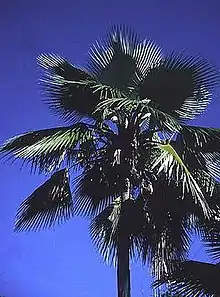| Stickybud pritchardia | |
|---|---|
 | |
| Scientific classification | |
| Kingdom: | Plantae |
| Clade: | Tracheophytes |
| Clade: | Angiosperms |
| Clade: | Monocots |
| Clade: | Commelinids |
| Order: | Arecales |
| Family: | Arecaceae |
| Tribe: | Trachycarpeae |
| Genus: | Pritchardia |
| Species: | P. viscosa |
| Binomial name | |
| Pritchardia viscosa | |
Pritchardia viscosa, the stickybud pritchardia[2] or loʻulu, is an extremely rare endangered species of Pritchardia palm that is endemic to the Hawaiian island of Kauaʻi.[3]
It inhabits open wet forests in the Kalihiwai Valley, where it grows at altitudes of 500–700 m (1,600–2,300 ft). Associated plants include ʻaiea (Ilex anomala), ʻahakea (Bobea spp.), hame, (Antidesma spp.), hāpuʻu pulu (Cibotium glacum), and kōpiko (Psychotria hexandra).[3]
It is a medium-sized palm from 6–8 m (20–26 ft) tall, with palmate (fan-shaped) leaves about 1 m (3.3 ft) long. The fruit is produced in dense clusters, each fruit green, pear-shaped, 4 cm (1.6 in) long and 2.5 cm (0.98 in) in diameter.[3]
Like the related Nihoa Fan Palm (P. remota), it is susceptible to extinction by a single catastrophic event because of its wild population of four individuals. It is threatened by introduced rats, which eat the seeds. It has been cultivated to a moderate extent, but is exceptionally limited in its habitat.[3]
References
- ↑ Gemmill, C. 1998. Pritchardia viscosa. 2011 IUCN Red List of Threatened Species. Downloaded on 9 July 2011.
- ↑ USDA, NRCS (n.d.). "Pritchardia viscosa". The PLANTS Database (plants.usda.gov). Greensboro, North Carolina: National Plant Data Team. Retrieved 14 October 2015.
- 1 2 3 4 "Pritchardia viscosa". CPC National Collection Plant Profiles. Center for Plant Conservation. Archived from the original on 2010-10-27. Retrieved 2009-11-12.
External links
